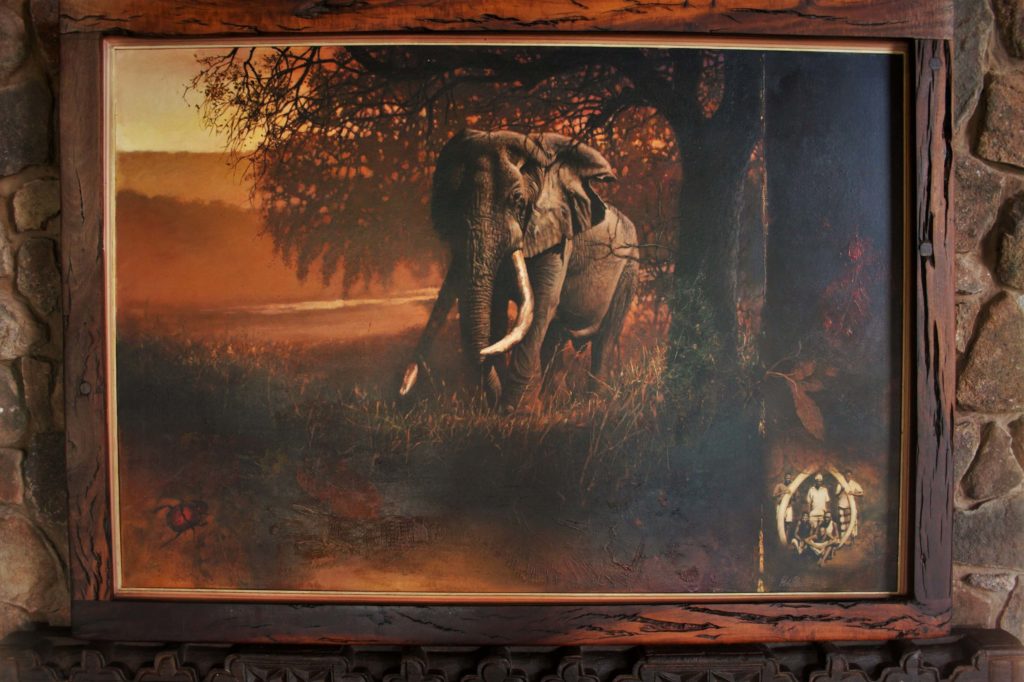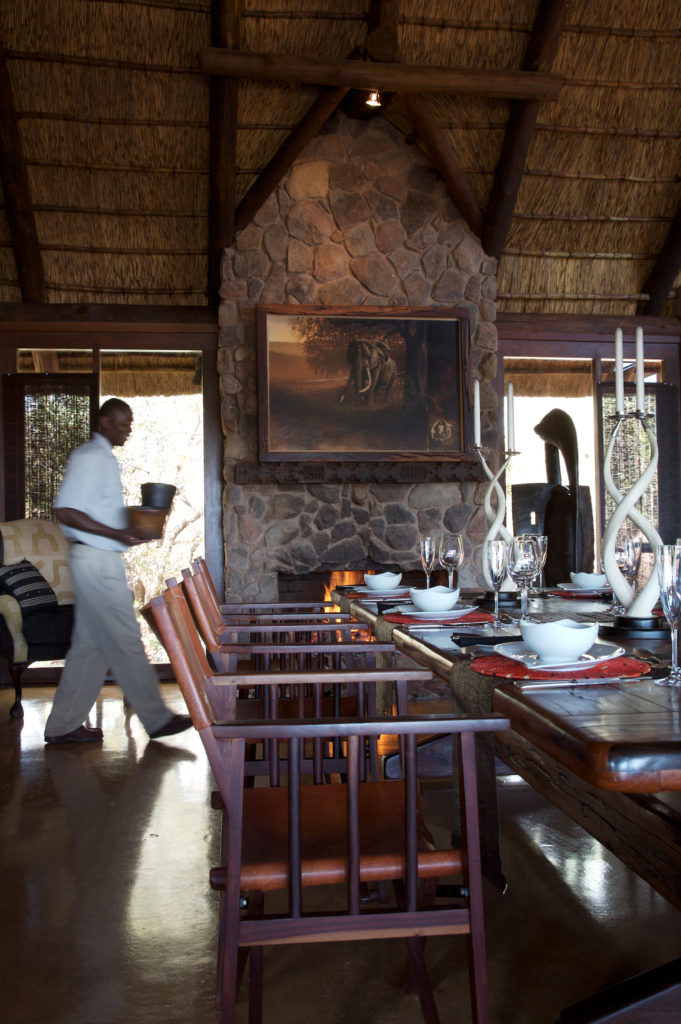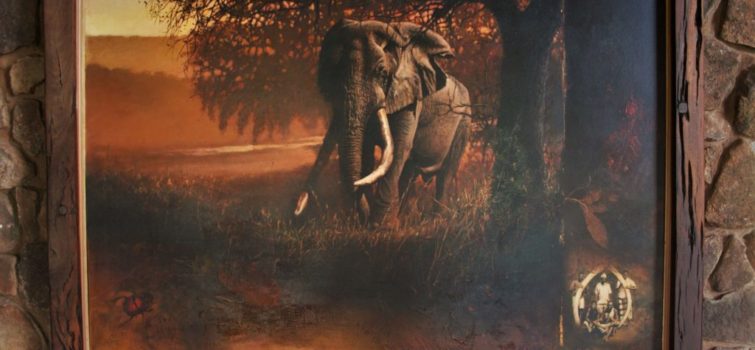The Elephant, The Artist and Makweti Safari Lodge
Ladies and gentlemen, in the left corner weighing in at 69kg, standing at 2,36 meters tall and in ivory trunks introducing… and in the right corner weighing in at 73,5kg, standing 2,33 meters tall and also in ivory trunks, introducing one of the greatest match ups of all time, ever recorded.
While this may seem like the introduction to a middleweight boxing match, it’s far from it. Let me explain. This story has three key parts, as the title would indicate, all culminating in a magnificent piece of art that is displayed in the dining area at Makweti Safari Lodge.
Makweti Safari Lodge
Makweti Safari Lodge has a number of unique characteristics, which sets it apart. The unique, authentic and original pieces of art within the camp are special to the Makweti family, and each has its own story.
One cannot enter the main lodge and enjoy a gourmet meal without noticing the painting depicting an elephant with a tear in his left ear. It is the topic of many conversations around the dining table, and it sparks much interest as a result of the artwork itself, the story behind it and the subject: Mandleve.
This majestic painting spans the wall above the fire place and is magnificent. When designing the dining area at Makweti Safari Lodge, this painting was so special to the owners that the stone wall itself was measured and built so it would accommodate the painting in this exact spot.

The Elephant – “Mandleve”
It’s the 1980s, Kruger National Park, and ivory poaching is rife throughout Africa. The general public has little interest in matters not concerning them, but they needed to be informed of the plight of elephants in Africa, and in particular here at home in South Africa, in the Kruger National Park.
Dr. Uys deVillers Pienaar, the then Chief Warden of the Kruger National Park, commissioned the park to publicise the largest elephant bulls in the reserve each carrying tusks that exceeded 50kg each. His intentions were to raise awareness around elephant poaching and generate public interest in the park, while also highlighting their conservation efforts in protecting these incredible animals. The “Magnificent 7” were born. Named after the 1960s classic film, the “Magnificent 7” were recorded as the largest “tuskers” in the reserve at the time. The original seven were named after areas of the reserve they frequented or were descriptions of particular characteristics or behaviours of each animal. They were Dzombo, Joao, Kambaku, Mafunyane, Ndlulamithi, Shawu and Shingwedzi. They were instant heroes and reached much local and global fame in a short period of time. Unfortunately, this limelight didn’t shine for long and by the mid-80s none of them were left roaming the Kruger National Park. Dzombo was killed by poachers on the Mozambique border and Kambaku eventually suffered from the results of a septic bullet wound and had to be put down. The rest died of natural causes.
This initiative paved the way for future public interest in Kruger’s great tuskers, and since then, the emerging great tuskers have been identified and hailed as the greatest elephants of the Kruger National Park.
Mandleve, arguably the greatest tusker to earn this reputation, is depicted in the artwork on display at Makweti Safari Lodge. His tusks were the greatest of them all, weighing in collectively 142.5kg (315 pounds) beating the previous record held by Phelwana at 135.5kg. Mandleve was easily recognised by his large tusks but more so by the large tear in his left ear. ‘Mandleve’, a Tsonga word for ‘ear’ or torn ear’ is how he derived his name. He was also believed to be named after Louis Olivier, a senior official in the Kruger at the time Mandleve was around.
He died of natural causes and his remains were found on the 11th June 1993. His carcass was found on the power line road near the Paul Kruger Gate. He was believed to be between 55 and 60 years of age. Andre Burger, the current COO of Welgevonden Game Reserve, who was working in the Kruger National Park at the time, under Louis Olivier, found Mandleve’s remains while on a routine flight over the park. Andre recalls:
“I was asked one day to assist with the black rhino census in Kruger as the designated counter was not available. If I recall correctly, the pilot was Piet Otto, who had many thousands of helicopter hours in Kruger and knew the park and its animals intimately from the air. We were flying towards Paul Kruger Gate to start the count when Piet says we need to keep an eye out for Mandleve as the area along the Sabie River was the area he frequented but he hadn’t seen him in some time. I was excited at the opportunity of seeing this animal. Unfortunately, not long after we started counting, we spotted the skeletal remains of an elephant and Piet immediately identified it as the carcass of Mandleve, from the shape and size of the tusks. Piet immediately landed the helicopter and we loaded the tusks, which were flown to Skukuza while we were left abandoned in the bush. If I recall correctly, the skeleton carcass was only a few hundred meters from the road and only a few kilometers from Paul Kruger Gate. Later that afternoon, I took photos of the tusks in the back of a Hilux and they were too long to fit in the back of the vehicle. A sad day indeed.”

The Artist
This beautiful painting of Mandleve was created by South African artist, Hannes du Plessis. The owners of Makweti Safari Lodge were intrigued by his artworks, and own three pieces produced by him. These paintings depict a kudu bull and two pieces of Mandleve, of which one is displayed at Makweti Safari Lodge.
The Mandleve painting at the camp depicts the elephant along a river bank, where he was frequently found. It includes an original photograph of ivory traders, which is indicative of the times when the Magnificent 7 roamed freely and the plight they faced with increasing poaching pressure on the larger tuskers. In the bottom left corner is a dung beetle, with the relief of a coelacanth fish to the right of it. The significance of these inclusions in the painting depicts the life span of elephants, being the largest land mammals with the longest life spans.
Hannes du Plessis was born in Hennenman in the Orange Free State in 1950. Educated at the Pretoria School of Art for advanced technical education, Hannes acquired the skills necessary to express his passion for life and the world around him. Working from his studio in Johannesburg, Hannes has been creatively involved in the arts since the late 70s. He believes that through observation, the spirit of a place can be portrayed, creating a narrative as you filter the visual experience through your own spirit and soul. In doing so, he aims to touch the heart of the observer. Hannes du Plessis’s naturalistic paintings are very well received. He has progressively made his mark on the international art market, with work in private and corporate collections throughout the world, including Japan, United States, Italy, Portugal, Germany, Great Britain and Australia. The work has evolved over the years in a meaningful way to display an integrity, maturity of style and technique, which underscores his commitment to his subject. Over and above his contributions to corporate and private art collections, Hannes receives commissions, parallel to his naturalistic work, for portraits of officials in government as well as a number of collectors and their families, producing some striking examples which reflect his intrinsic understanding of his subjects.
The inspiration of the Mandleve painting was to ‘capture the dimensions of the African bushveld and the essence of Africa’.
As magnificent as this great tusker was, so is the painting which depicts his lost spirit. It serves as a reminder to us of the true African experience, which is synonymous with Makweti Safari Lodge.
Special gratitude to the following people for providing more intimate insight into the painting, its story and to Mandleve.
- Hannes du Plessis – artist of the painting, thank you for the information into your inspiration and creativity when depicting this magnificent elephant displayed at Makweti Safari Lodge.
- Andre Burger – COO of Welgevonden Game Reserve, who found Mandleve’s carcass in the Kruger National Park. We are grateful for your input of this memorable day.
Photographs
- Mandleve Painting – Neil Davison
- Dining area, fire place, painting – David Ross
Text – Neil Davison
References:

